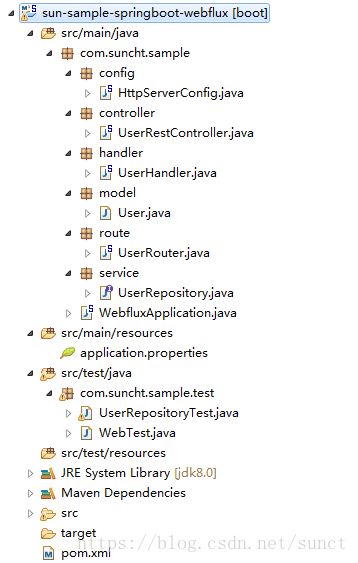SpringBoot系列:基于SpringBoot2.0的WebFlux应用入门
Spring WebFlux是在Spring框架5中引入的一种新的反应式Web框架。与Spring MVC不同,它不需要servlet API,完全异步和非阻塞,并通过Reactive Project实现Reactive Streams规范。
官网文档地址:
https://docs.spring.io/spring/docs/5.0.5.RELEASE/spring-framework-reference/web-reactive.html#webflux
1、创建一个SpringBoot2.0项目
Eclipse中创建Maven工程,也可以使用Spring Initializer创建,在Pom.xml中添加依赖:
注意:SpringBoot2.0仅支持JDK8.0以上,不支持JDK6、JDK7
4.0.0
com.sample
sun-sample-springboot-webflux
0.0.1-SNAPSHOT
org.springframework.boot
spring-boot-dependencies
2.0.1.RELEASE
pom
import
org.springframework.boot
spring-boot-starter
org.springframework.boot
spring-boot-starter-webflux
org.springframework.boot
spring-boot-starter-data-jpa
com.h2database
h2
org.springframework.boot
spring-boot-starter-test
test
org.springframework.boot
spring-boot-maven-plugin
Spring-boot-starter-webflux 将 spring-webflux、netty 以及其他必须的依赖包引入到类路径中。
h2database 是h2内存数据库,用于快速测试
jpa 是ORM操作,快速编写CRUD
工程主函数代码如下:
package com.suncht.sample;
import org.springframework.boot.SpringApplication;
import org.springframework.boot.autoconfigure.SpringBootApplication;
@SpringBootApplication
public class WebfluxApplication {
public static void main(String[] args) {
SpringApplication.run(WebfluxApplication.class, args);
}
}application.properties属性文件配置如下:
server.port=8080
spring.datasource.url=jdbc:h2:file:D\:/h2/h2test;AUTO_SERVER=TRUE;DB_CLOSE_DELAY=-1
spring.datasource.driver-class-name=org.h2.Driver
spring.datasource.username=sa
spring.datasource.password=
spring.jpa.database-platform=org.hibernate.dialect.H2Dialect
spring.jpa.hibernate.ddl-auto=update
spring.jpa.properties.hibernate.show_sql=true
spring.jpa.properties.hibernate.use_sql_comments=true
spring.jpa.properties.hibernate.format_sql=true
spring.h2.console.enabled=true
spring.h2.console.path=/console
spring.h2.console.settings.trace=false
spring.h2.console.settings.web-allow-others=false
#logging.level.root=debug2、创建 HttpServer
package com.suncht.sample.config;
import org.springframework.beans.factory.annotation.Autowired;
import org.springframework.context.annotation.Bean;
import org.springframework.context.annotation.Configuration;
import org.springframework.core.env.Environment;
import org.springframework.http.server.reactive.HttpHandler;
import org.springframework.http.server.reactive.ReactorHttpHandlerAdapter;
import org.springframework.web.reactive.function.server.RouterFunction;
import org.springframework.web.reactive.function.server.RouterFunctions;
import reactor.ipc.netty.http.server.HttpServer;
/**
* 配置HttpServer
* 可以配置基于Netty、基于Tomcat、基于Jetty
* @author suncht
*
*/
@Configuration
public class HttpServerConfig {
@Autowired
private Environment environment;
@Bean
public HttpServer httpServer(RouterFunction routerFunction) {
HttpHandler httpHandler = RouterFunctions.toHttpHandler(routerFunction);
ReactorHttpHandlerAdapter adapter = new ReactorHttpHandlerAdapter(httpHandler);
HttpServer server = HttpServer.create("localhost", Integer.valueOf(environment.getProperty("server.port")));
server.newHandler(adapter);
return server;
}
}这个根据应用配置中指定的端口创建一个 Netty HttpServer 服务器。Spring 支持例如 Tomcat 或者 Undertow 等其他服务器。因为 Netty 本身是异步的和事件驱动的,因此它更适合用来运行 Reactive 应用。而 Tomcat 使用 Java NIO 来实现 Servlet 规范。Netty 的 NIO 实现专门针对异步、事件驱动和非堵塞应用进行了优化。
3、编写Http请求的业务逻辑
WebFlux 支持两种编程:
(1)使用@Controller这种基于注解的姿势, 与Sring MVC的姿势相同,最简单最简洁
(2)基于Java 8 Lambda的函数式编程风格,需要编写Handler和Router
第一方式:基于注解
package com.suncht.sample.controller;
import java.util.List;
import java.util.Optional;
import org.springframework.beans.factory.annotation.Autowired;
import org.springframework.web.bind.annotation.GetMapping;
import org.springframework.web.bind.annotation.PathVariable;
import org.springframework.web.bind.annotation.RequestMapping;
import org.springframework.web.bind.annotation.RestController;
import com.suncht.sample.model.User;
import com.suncht.sample.service.UserRepository;
/**
* WebFlux的第一种方式: annotation-based(注解)
* @author suncht
*
*/
@RestController
@RequestMapping("/users")
public class UserRestController {
@Autowired
private UserRepository userRepository;
@GetMapping("/")
public List getAllUser() {
return userRepository.findAll();
}
@GetMapping("/{id}")
public User getUser(@PathVariable Long id) {
Optional user = userRepository.findById(id);
return user.get();
}
@GetMapping("/add/{userName}/{age}")
public Long getUser(@PathVariable("userName") String userName, @PathVariable("age") Integer age) {
User user = new User();
user.setUserName(userName);
user.setAge(age);
User result = userRepository.save(user);
return result.getId();
}
}
第二种方式:基于函数
package com.suncht.sample.handler;
import java.util.Optional;
import org.springframework.beans.factory.annotation.Autowired;
import org.springframework.stereotype.Service;
import org.springframework.web.reactive.function.server.ServerRequest;
import org.springframework.web.reactive.function.server.ServerResponse;
import com.suncht.sample.model.User;
import com.suncht.sample.service.UserRepository;
import reactor.core.publisher.Mono;
/**
* UserHandler
* 用户操作的业务逻辑
* @author suncht
*
*/
@Service
public class UserHandler {
@Autowired
private UserRepository userRepository;
public Mono handleGetUserById(ServerRequest request) {
Long userId = Long.valueOf(request.pathVariable("id"));
Optional user = userRepository.findById(userId);
return ServerResponse.ok().body(Mono.just(user.get()), User.class)
.switchIfEmpty(ServerResponse.notFound().build());
}
} 这是针对用户的handler,其实就是用户的业务逻辑操作而已。跟我们平时写的业务逻辑不同是:返回对象Mono和Flux。
关于Mono和Flux,请参考官网:https://docs.spring.io/spring/docs/5.0.5.RELEASE/spring-framework-reference/web-reactive.html#webflux-fn-handler-functions
package com.suncht.sample.route;
import org.springframework.context.annotation.Bean;
import org.springframework.context.annotation.Configuration;
import org.springframework.http.MediaType;
import org.springframework.web.reactive.function.server.RequestPredicates;
import org.springframework.web.reactive.function.server.RouterFunction;
import org.springframework.web.reactive.function.server.RouterFunctions;
import com.suncht.sample.handler.UserHandler;
/**
* WebFlux的第二种方式: functional(java方法)
* Router路由,其实就是用代码实现http请求路径,类似于Python Web框架django,手动编写路由代码
* @author suncht
*
*/
@Configuration
public class UserRouter {
@Bean
public RouterFunction routerFunction(UserHandler userHandler) {
return RouterFunctions
.route(RequestPredicates.GET("/api/user/{id}")
.and(RequestPredicates.accept(MediaType.APPLICATION_JSON)), userHandler::handleGetUserById);
}
}
这是用户http请求的路由规则,手动编写。较第一方法而言,比较麻烦。
4、测试
可以在浏览器中直接输入HTTP地址:http://127.0.0.1:8080/api/user/2 进行测试
也可以使用WebFlux中的WebClient测试,代码如下:
package com.suncht.sample.test;
import java.util.List;
import org.junit.Before;
import org.junit.Test;
import org.springframework.http.MediaType;
import org.springframework.web.reactive.function.client.WebClient;
import com.suncht.sample.model.User;
import reactor.core.publisher.Flux;
import reactor.core.publisher.Mono;
public class WebTest {
private WebClient client = null;
@Before
public void init() {
client = WebClient.create("http://127.0.0.1:8080/");
}
@Test
public void testUserById() {
Mono result = client.get()// 请求方法,get,post...
.uri("users/{id}", "1")// 请求相对地址以及参数
.accept(MediaType.APPLICATION_JSON).retrieve()// 请求类型
.bodyToMono(User.class);// 返回类型
User user = result.block();
System.out.println(user);
}
@Test
public void testUserById2() {
Mono result2 = client.get()// 请求方法,get,post...
.uri("api/user/{id}", "1")// 请求相对地址以及参数
.accept(MediaType.APPLICATION_JSON).retrieve()// 请求类型
.bodyToMono(User.class);// 返回类型
User user2 = result2.block();
System.out.println(user2);
}
@Test
public void testAllUsers() {
Flux userFlux = client.get()
.uri("users/")
.accept(MediaType.APPLICATION_JSON).retrieve()// 请求类型
.bodyToFlux(User.class);// 返回类型
List users = userFlux.collectList().block();
System.out.println(users);
}
} WebClient是远程调用Http请求的一种工具类、新思路
5、其他代码
User实体:
package com.suncht.sample.model;
import java.io.Serializable;
import javax.persistence.Column;
import javax.persistence.Entity;
import javax.persistence.GeneratedValue;
import javax.persistence.GenerationType;
import javax.persistence.Id;
import javax.persistence.Table;
@Entity
@Table(name = "t_user")
public class User implements Serializable {
private static final long serialVersionUID = 1L;
@Id
@GeneratedValue(strategy = GenerationType.IDENTITY)
private Long id;
@Column(name="user_name", nullable=false, length=50)
private String userName;
@Column(name="age")
private Integer age;
public Long getId() {
return id;
}
public void setId(Long id) {
this.id = id;
}
public String getUserName() {
return userName;
}
public void setUserName(String userName) {
this.userName = userName;
}
public Integer getAge() {
return age;
}
public void setAge(Integer age) {
this.age = age;
}
@Override
public String toString() {
return "User [id=" + id + ", userName=" + userName + ", age=" + age + "]";
}
}
针对User的JPA CRUD操作:
package com.suncht.sample.service;
import org.springframework.data.jpa.repository.JpaRepository;
import com.suncht.sample.model.User;
public interface UserRepository extends JpaRepository {
} 6、整个工程项目结构预览
GitHub代码: https://github.com/suncht/sun-test/tree/master/springboot2.webflux.test
